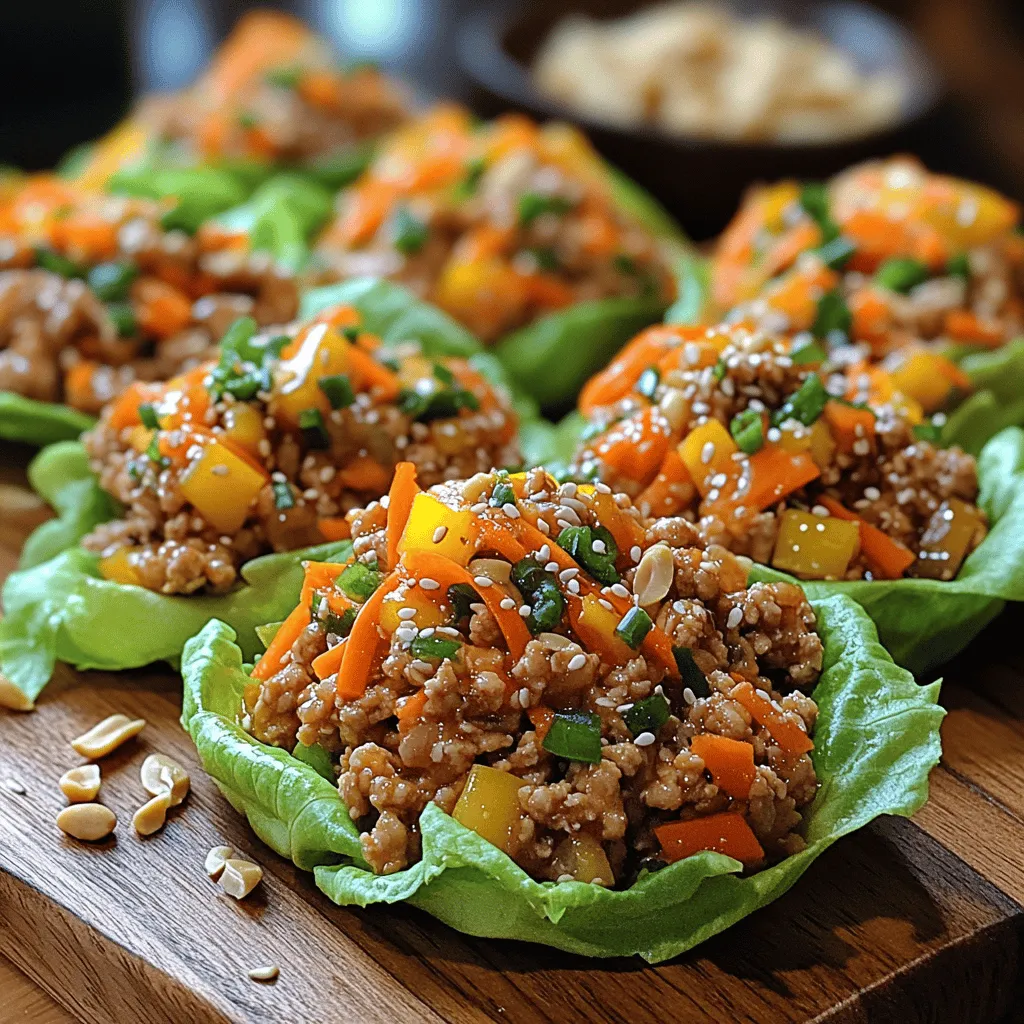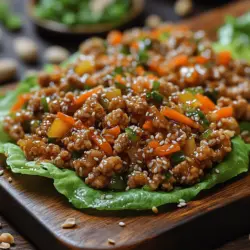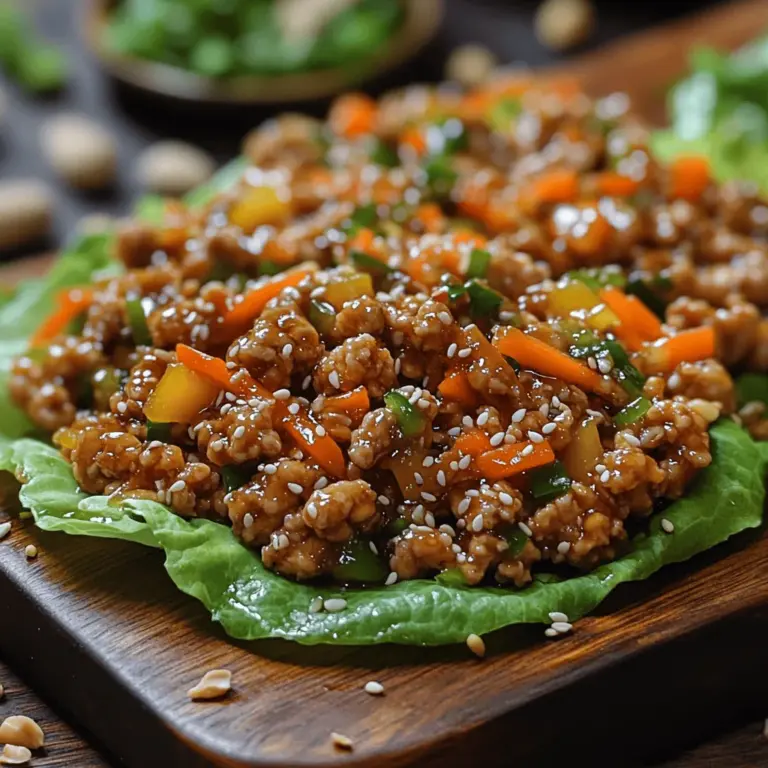Introduction
In the ever-evolving landscape of culinary trends, the popularity of healthier dining options continues to gain momentum. Among these, Sesame Ginger Chicken Lettuce Wraps have emerged as a favorite, not just for their vibrant flavors but also for their health-conscious appeal. These wraps serve as a delightful alternative to traditional wraps, substituting hearty tortillas with crisp, fresh lettuce leaves. The result is a dish that is not only visually stunning but also offers a fresh and invigorating dining experience.
Lettuce wraps are particularly appealing for those seeking a low-calorie meal without sacrificing flavor. The combination of tender ground chicken, fragrant sesame oil, and zesty ginger creates a harmonious blend of flavors and textures. This recipe tantalizes the taste buds while delivering a satisfying crunch, making each bite a delicious adventure. Whether you’re looking to impress guests at a dinner party or simply treat yourself to a healthy meal, these Sesame Ginger Chicken Lettuce Wraps are sure to become a staple in your culinary repertoire.
Understanding the Ingredients
To create the perfect Sesame Ginger Chicken Lettuce Wraps, understanding the role of each ingredient is essential. Each component contributes not only to the dish’s flavor but also to its nutritional profile.
Ground Chicken: Protein Source and Texture
Ground chicken serves as the primary protein in this dish. It’s a leaner alternative to ground beef or pork, providing a similar texture while being lower in fat. This makes it an excellent choice for those looking to maintain a balanced diet without feeling deprived. Ground chicken is versatile and easily absorbs the flavors of the other ingredients, making it the perfect base for our wraps.
Sesame Oil: Flavor Profile and Health Benefits
Sesame oil is a key player in this recipe, imparting a nutty and rich flavor that elevates the dish. Not only does it enhance the taste, but it also offers several health benefits. Rich in antioxidants and healthy fats, sesame oil can contribute to heart health and may even have anti-inflammatory properties. Its distinct flavor pairs beautifully with the ginger and garlic, creating a depth that is both comforting and exciting.
Garlic and Ginger: Aromatics and Their Health Properties
Garlic and ginger are two aromatic ingredients that form the backbone of many Asian dishes, including our Sesame Ginger Chicken Lettuce Wraps. Garlic is known for its immune-boosting properties and potential cardiovascular benefits, while ginger adds a warm, spicy kick and is celebrated for its digestive health benefits. Together, they create a fragrant base that enhances the overall flavor profile of the dish.
Low-Sodium Soy Sauce: Flavor Enhancer and Alternative to Traditional Sauces
To add umami and a savory depth, low-sodium soy sauce is incorporated into the recipe. It provides the salty flavor typically associated with soy sauce but in a healthier manner, reducing the overall sodium content of the dish. This thoughtful choice allows you to enjoy the rich taste of soy sauce without the guilt, making it suitable for various dietary restrictions.
Rice Vinegar and Honey/Maple Syrup: Balancing Acidity and Sweetness
To achieve a well-rounded flavor, rice vinegar is included for its mild acidity, which balances the richness of the sesame oil and chicken. In contrast, honey or maple syrup introduces a hint of sweetness, creating a delightful contrast that rounds out the dish. These ingredients work together to create a sauce that is bright, flavorful, and irresistible.
Vegetables: Nutritional Benefits and Color
Colorful vegetables play a vital role in this recipe. Not only do they add visual appeal, but they also bring a wealth of nutrients. Bell peppers, carrots, and green onions can be included for added crunch and flavor. These vegetables are packed with vitamins and minerals, contributing to the overall health benefits of the dish. Their nutritional density enhances the meal, making it a wholesome option that supports a balanced diet.
Optional Ingredients: Discussion on the Impact of Cilantro and Peanuts
While our primary ingredients create a delicious foundation, optional ingredients such as fresh cilantro and chopped peanuts can elevate the dish even further. Cilantro adds a refreshing herbaceous note that brightens the overall flavor, while peanuts provide a satisfying crunch and additional protein. These optional add-ins allow you to customize your wraps to suit your personal taste preferences, making each meal a unique experience.
Health Benefits of Lettuce Wraps
Lettuce wraps are more than just a trendy culinary choice; they are a health-conscious alternative to traditional wraps. By replacing tortillas with lettuce, you significantly reduce the calorie count of your meal, making it easier to maintain a healthy diet. This simple swap allows you to enjoy a filling meal without the extra carbs, which can be particularly beneficial for those following low-carb or ketogenic diets.
The combination of lean protein from the ground chicken and the nutrient-rich vegetables creates a well-balanced meal. Lettuce wraps encourage the consumption of more vegetables, which are vital for overall health. Increased vegetable intake is associated with numerous benefits, including improved digestion, enhanced skin health, and reduced risk of chronic diseases.
Moreover, the inclusion of lean protein is essential for muscle maintenance and repair, making these wraps an excellent post-workout meal option. By incorporating these healthful components into your diet, you support your body’s nutritional needs while enjoying a flavorful and satisfying dish.
Step-by-Step Cooking Instructions
Now that we have a thorough understanding of the ingredients and their benefits, let’s dive into the preparation of our Sesame Ginger Chicken Lettuce Wraps. This step-by-step guide will help even novice cooks create a delicious and satisfying meal.
Cooking the Chicken: Techniques for Browning and Flavoring
1. Preheat the pan: Start by heating a large skillet or wok over medium-high heat. This ensures that the chicken will brown nicely when added to the pan.
2. Add oil: Pour in a tablespoon of sesame oil to the heated pan. Allow it to heat up for a few moments until it shimmers, indicating that it’s ready for cooking.
3. Cook the chicken: Add the ground chicken to the pan, breaking it apart with a spatula as it cooks. Stir frequently for about 5-7 minutes, or until the chicken is cooked through and lightly browned. This technique not only ensures even cooking but also allows for a nice caramelization, enhancing the overall flavor.
Incorporating Aromatics: Importance of Timing and Technique
4. Add aromatics: Once the chicken is nearly cooked, it’s time to introduce our garlic and ginger. Add minced garlic and freshly grated ginger to the pan. Stir them in and sauté for an additional 1-2 minutes, or until the aromatics are fragrant. Be careful not to burn the garlic, as it can turn bitter.
Mixing the Sauce: Tips for Achieving the Right Balance of Flavors
5. Prepare the sauce: In a small bowl, whisk together low-sodium soy sauce, rice vinegar, and honey or maple syrup. Taste the sauce and adjust the balance of flavors as needed. If you prefer a sweeter sauce, add a touch more honey or maple syrup. For a saltier flavor, consider a splash more of soy sauce.
6. Combine with chicken: Pour the sauce over the cooked chicken mixture in the skillet. Stir well to ensure that all the chicken is coated with the sauce. Allow it to simmer for a few minutes, letting the flavors meld together and the sauce thicken slightly.
Adding Vegetables: Ensuring They Maintain Color and Crunch
7. Incorporate vegetables: Finally, add your choice of colorful vegetables to the skillet. Diced bell peppers, shredded carrots, and chopped green onions are all excellent options. Toss them into the chicken mixture and stir-fry for an additional 2-3 minutes. This quick cooking time ensures the veggies remain vibrant and retain their crunch, adding both texture and visual appeal to your wraps.
With the chicken and sauce fully combined and the vegetables just tender, your filling is now complete and ready to serve.
As we conclude this portion of our recipe exploration, you’ll be well on your way to preparing delicious Sesame Ginger Chicken Lettuce Wraps that are not only bursting with flavor but also packed with nutrients. Stay tuned for the subsequent sections, where we’ll delve deeper into additional cooking tips, variations of the recipe, and answers to common questions regarding this delightful dish.

Visual Cues to Look for During the Cooking Process
When preparing your Sesame Ginger Chicken Lettuce Wraps, there are several key visual indicators to watch for that can help ensure your chicken is cooked to perfection. As you sauté the chicken mixture, look for a few signs:
1. Color Change: The chicken should turn from pink to a uniform white or light brown color, indicating that it is thoroughly cooked. Avoid overcooking, as this can lead to dry meat.
2. Texture: As you stir-fry, the chicken should become opaque and slightly crispy on the edges. This caramelization adds a depth of flavor to the dish.
3. Vegetable Cook: The vegetables should become tender but still retain a slight crunch. This ensures they provide a nice texture contrast in the wraps.
4. Sauce Consistency: The sauce should thicken slightly as it cooks. Look for a glossy finish on the chicken and vegetables, which indicates that the sauce is well-distributed.
Assembling the Lettuce Wraps
Choosing the right type of lettuce is crucial for an enjoyable wrap experience. Lettuce wraps are as much about the filling as they are about the vessel that holds them, so consider these options:
Choosing the Right Type of Lettuce: Comparison of Butter and Romaine
– Butter Lettuce: This variety is characterized by its soft, pliable leaves that cradle fillings beautifully. The mild flavor complements the savory chicken filling without overpowering it. The leaves are also easy to fold, making them ideal for wraps.
– Romaine Lettuce: Romaine offers a crisper texture, providing a satisfying crunch that many enjoy. The thicker leaves can hold more filling without tearing, but they may require a bit more finesse when wrapping.
Techniques for Preparing Lettuce Leaves for Wrapping
1. Washing: Rinse the lettuce leaves under cold water to remove dirt and pesticides. Shake off excess water or use a salad spinner for best results.
2. Removing Leaves: Gently separate the leaves from the head. Keep the larger outer leaves for wraps, as they are sturdier.
3. Trimming: If the leaves are particularly large or thick, trim the base slightly to make them easier to fold and eat.
4. Drying: Pat the leaves dry with a paper towel to prevent any excess moisture from wilting them.
Tips for Assembly to Prevent Spills and Enhance Presentation
– Spoon Technique: Use a spoon to scoop the chicken filling into the center of the lettuce leaf. Avoid overstuffing, as this can lead to spills. Aim for about 2 tablespoons of filling per leaf.
– Folding: Fold the sides of the lettuce over the filling and then roll it up from the bottom. This technique mimics a burrito wrap and keeps the filling secure.
– Garnishing: Top each wrap with chopped scallions, sesame seeds, or a drizzle of additional sauce for an appealing presentation. Arrange the wraps on a platter for serving, and consider adding herbs like cilantro for color.
Serving Suggestions
Pairing your Sesame Ginger Chicken Lettuce Wraps with the right accompaniments can elevate the meal. Here are some suggestions:
– Dips: Serve with a side of hoisin sauce, peanut sauce, or a spicy sriracha mayo for dipping. These add extra flavor and richness.
– Sides: Complement the wraps with a light side salad or steamed vegetables for a well-rounded meal. A refreshing cucumber salad can also balance the savory flavors.
– Presentation Tips: Use a rustic wooden board or a colorful plate to arrange the wraps. Garnish with fresh herbs or edible flowers for a beautiful display that enhances the dining experience.
Variations of the Dish
To keep things exciting, consider these variations of Sesame Ginger Chicken Lettuce Wraps:
– Different Proteins: Swap the chicken for ground turkey, beef, or even shrimp for a different flavor profile. For a plant-based option, use crumbled tofu or tempeh sautéed with the same seasonings.
– Vegetable Boost: Add finely chopped mushrooms, bell peppers, or zucchini to the filling for extra nutrients and texture.
– Seasoning Variations: Experiment with different sauces such as teriyaki or sweet chili sauce, adjusting the sweetness and spice levels to your preference.
Storing and Reheating Leftovers
If you have leftover filling after making your wraps, here are some best practices for storing and reheating:
Best Practices for Storing Leftovers to Maintain Freshness
– Storage: Keep the chicken filling in an airtight container in the refrigerator for up to three days. Ensure it cools to room temperature before sealing to prevent condensation.
– Lettuce Storage: Store any unused lettuce leaves wrapped in a damp paper towel in a sealed bag or container to keep them crisp.
Guidelines for Reheating the Chicken Filling Without Losing Flavor
– Microwave: Reheat the filling in the microwave for 30-second intervals, stirring in between, until heated through. Avoid overheating to prevent dryness.
– Stovetop: For even heating, place the filling in a skillet over medium heat. Add a splash of water or broth to maintain moisture, stirring frequently.
Creative Ideas for Using Leftover Filling in Other Meals
– Bowls: Use the chicken filling as a base for a rice or quinoa bowl. Top with fresh vegetables and your choice of sauce.
– Tacos: Serve the filling in soft tortillas with avocado, salsa, and cheese for a quick meal.
– Stir-Fry: Incorporate the leftover filling into a stir-fry with additional vegetables, serving it over noodles or rice.
Flavor Variations and Customizations
Customization allows you to tailor your dish to suit your taste preferences perfectly. Here are some suggestions:
Suggestions for Ingredient Swaps
– Protein Alternatives: For a vegetarian option, use chickpeas or lentils. For a more unique flavor, consider duck or pork.
– Sauce Substitutions: Switch out soy sauce for coconut aminos for a gluten-free option or try a spicy chili garlic sauce for heat.
Spice Level Adjustments
– Heat: If you enjoy spice, add chili flakes, sriracha, or diced jalapeños to the filling. Start with a small amount and adjust according to taste.
– Mild Alternatives: For a milder version, omit any spicy ingredients and increase the sweetness with a touch of honey or maple syrup.
Additional Toppings
– Crunch: Add toasted peanuts or cashews for a satisfying crunch.
– Freshness: Incorporate fresh herbs like cilantro or basil for added flavor and a pop of color.
Cultural Context of Lettuce Wraps
Lettuce wraps have deep roots in various Asian cuisines, particularly in Chinese and Thai cooking. These wraps are not only about taste but also about presentation, offering a fresh and interactive dining experience.
Brief History of Lettuce Wraps in Asian Cuisine
The concept of wrapping fillings in leafy greens can be traced back centuries, with dishes like “San Choy Bao” in China, which features minced meat and vegetables served in lettuce cups. This method of eating emphasizes the balance of flavors and textures, a hallmark of Asian culinary traditions.
Evolution of the Dish in Modern Cooking
In recent years, lettuce wraps have gained popularity in Western cuisine, often featured on menus as a healthy alternative to traditional sandwiches and wraps. Restaurants capitalize on the low-carb and gluten-free aspects, appealing to health-conscious diners.
Popularity in Health-Conscious Diets and Restaurants
The rise in demand for healthier eating options has propelled lettuce wraps into the spotlight. They are viewed as a versatile dish that can cater to various dietary needs, from low-carb diets to vegetarian and vegan lifestyles.
Conclusion
In conclusion, Sesame Ginger Chicken Lettuce Wraps are a delightful combination of savory flavors, refreshing textures, and versatile presentation. This dish offers numerous health benefits, packed with protein and vegetables, while remaining low in carbs. The ease of preparation makes it an excellent choice for weeknight dinners, meal prep, or entertaining guests.
With the ability to personalize the recipe to your taste, whether through different proteins, spices, or toppings, the possibilities are endless. Embrace the joy of creating these wraps at home, and don’t hesitate to explore and adapt the recipe to make it uniquely yours. Enjoy the process as much as the delicious outcome!

